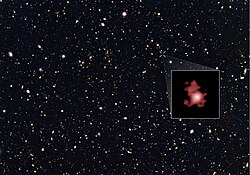Astrophysical origin
Analysis indicated the signal resulted from the coalescence of two black holes with 14.2+8.3
−3.7 and 7.5+2.3
−2.3 times the mass of the Sun, at a distance of 440+180
−190 megaparsecs (1.4 billion light years) from Earth. The resulting merged black hole had 20.8+6.1
−1.7 solar masses, one solar mass having been radiated away. [1] [3] In both of the first two black hole mergers analyzed, the mass converted to gravitational waves was roughly 4.6% of the initial total.
In this second detection, LIGO Scientific Collaboration and Virgo scientists also determined that at least one of the premerger black holes was spinning at more than 20% of the maximum spin rate allowed by general relativity. [1] [4] The final black hole was spinning with 0.74+0.06
−0.06 times its maximum possible angular momentum. [1] The black holes were smaller than in the first detection event, which led to different timing for the final orbits and allowed LIGO to see more of the last stages before the black holes merged—55 cycles (27 orbits) over one second, with frequency increasing from 35 to 450 Hz, compared with only ten cycles over 0.2 second in the first event. [1] [5]
The location/direction in the sky is poorly constrained. The signal was first seen at Livingston with delay of 1.1 (±0.3) ms later at LIGO Hanford. [1]
This page is based on this
Wikipedia article Text is available under the
CC BY-SA 4.0 license; additional terms may apply.
Images, videos and audio are available under their respective licenses.






